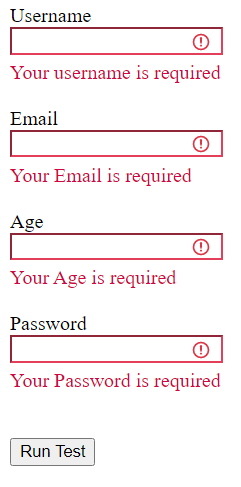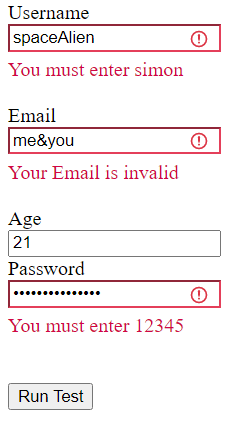Form validation is very important to prevent unwanted/malformed data from being stored in your database.
One wrong input from a user can affect the whole records in a database, so it is necessary to validate all form inputs before they are stored in a database.
Recently, I built a Library that helps to validate your forms server-side with PHP, and in this tutorial, I will show you how to use it in your project.
DEMO FILE
I will work with a demo PHP file that submits the form post data to itself.
Here's my demo file
<html>
<body>
<form id="form_demo" method="post" novalidate>
<label>Username</label><br>
<input name="username" type="text" id="inp_uname"> <br>
<label>Email</label><br>
<input name="email" type="email" id="inp_email"> <br>
<label>Age</label><br>
<input name="age" type="number" id="inp_age"> <br>
<label>Password</label><br>
<input name="password" type="password" id="inp_pass"> <br><br>
<button type="submit">Run Test</button>
</form>
</body>
</html>
This is what the form looks like
IMPORTING THE LIBRARY
We have to download and import the validation library to our project in order to begin validation on the form.
Visit the GitHub repository and download the library
 Octagon-simon
/
octaValidate-PHP
Octagon-simon
/
octaValidate-PHP
This PHP Library helps to validate your forms using regular expressions & validation rules.
octaValidate-PHP V2.0
This is a feature-rich Library that helps to validate your forms server-side using sophisticated regular expressions, PHP's inbuilt validation, and validation rules.
We have included a demo folder containing some forms with validation rules applied to each of them. Open any of the files in your local server and submit the form.
This Library also helps to validate your frontend forms using JavaScript. Visit the repository
OTHER RELEASES
Octavalidate - JS
Use the JavaScript release of this library to validate your frontend forms.
Octavalidate - NodeJS
Use the NodeJS release of this library to validate your forms server-side.
DOCUMENTATION
Visit the DOCUMENTATION to learn more about this GREAT Library, and play with the forms there!
INSTALL
COMPOSER
$ composer require simon-ugorji/octavalidate-php
LOCAL
- Download and import the latest release to your project.
- In your project, use the require keyword & include the file…
After downloading the library, this is how I will import the library to the project
//include the validation file
require 'octaValidate-php/src/Validate.php';
use Validate\octaValidate;
//create new instance of the class
$DemoForm = new octaValidate('form_demo');
Now we are ready to begin validation on the form.
DEFINING VALIDATION RULES
In order to begin validation, we need to;
- Define validation rules for the form.
- Invoke the
validateFields()method and pass in the rules as the first argument and then the form fields as the second argument
On this page, you will see a list of inbuilt validation rules, that can be used on your forms.
Here's the syntax to define validation rules for a form
//syntax for defining validation rules
$valRules = array(
"FORM_INPUT_NAME" => array(
["RULE_TITLE", "CUSTOM_ERROR_MESSAGE"]
)
);
So for the form inputs above, I want them to have these rules
- Username
- R (required)
- Email
- R (required)
- EMAIL (Checks if the value is a valid email address)
- Age
- R (required)
- DIGITS (Checks if the value is a valid digit)
- Password
- R (required)
This is how I will define the rules
//define validation rules
$valRules = array(
"username" => array(
["R", "Your username is required"]
),
"email" => array(
["R", "Your Email is required"],
["EMAIL", "Your Email is invalid"]
),
"age" => array(
["R", "Your Age is required"],
["DIGITS", "Your Age must be in digits"]
),
"password" => array(
["R", "Your Password is required"]
)
);
INVOKING THE VALIDATE FIELDS METHOD
Now that we have defined the rules, we need to invoke the validateFields() method and pass in the rules as the first argument and then the form fields as the second argument.
The form fields can be the $_POST or $_GET array. It defaults to the $_POST array if no value is provided.
With this, you can choose to validate data coming from the $_POST array or from the $_GET array, or even from the $_REQUEST array.
The validateFields() method returns boolean
- true means there are no validation errors
If there are no validation errors, you are free to process the form data and probably store the data in a database
- false means there are validation errors
If there are validation errors, we need to return the errors back to the user by invoking the getErrors() method.
While returning the errors back to the user, you need to have a JavaScript function that will append the errors into the form since it is a server-side library. Luckily for us, the library comes with a helper script that is available in /frontend/helper.js.
The helper script contains 2 functions which are;
- showErrors(errorObject)
Pass in the error object to this function for the function to append the errors into the form.
- removeErrors(formId)
Pass in a form ID to this function for the function to remove any errors present within the form.
You don't need to call the
removeErrors()function if your form is submitted to the page itself or to another PHP script, because the page will reload on every submit. However, it is necessary that you call the function if you're using Ajax to process form submission.
Locate this script and include the functions there in your project.
So this is how I will handle the result of the validateFields() method
//begin validation
if ( $DemoForm->validateFields($valRules, $_POST) === true ){
//process form data here
}else{
//retrieve & display errors
print('<script>
window.addEventListener(\'load\', function(){
showErrors(' . $DemoForm->getErrors() . ');
})
</script>');
}
Here's the full code of the demo page
<?php
//require library
require 'octaValidate-php/src/Validate.php';
use Validate\octaValidate;
//create new instance of the class
$DemoForm = new octaValidate('form_demo');
//define validation rules
$valRules = array(
"username" => array(
["R", "Your username is required"]
),
"email" => array(
["R", "Your Email is required"],
["EMAIL", "Your Email is invalid"]
),
"age" => array(
["R", "Your Age is required"],
["DIGITS", "Your Age must be in digits"]
),
"password" => array(
["R", "Your Password is required"]
)
);
if ($_POST) {
//begin validation
if ( $DemoForm->validateFields($valRules, $_POST) === true ) {
//process form data here
print('<script> alert("NO VALIDATION ERROR") </script>'); }
else {
//retrieve & display errors
print('<script>
window.addEventListener(\'load\', function(){
showErrors(' . $DemoForm->getErrors() . ');
})
</script>');
}
}
?>
<html>
<body>
<form id="form_demo" method="post" novalidate>
<label>Username</label><br>
<input name="username" type="text" id="inp_uname" value="<?php ($_POST && $_POST['username']) ? print($_POST['username']) : '' ?>"> <br>
<label>Email</label><br>
<input name="email" type="email" id="inp_email" value="<?php ($_POST && $_POST['email']) ? print($_POST['email']) : '' ?>"> <br>
<label>Age</label><br>
<input name="age" type="number" id="inp_age" value="<?php ($_POST && $_POST['age']) ? print($_POST['age']) : '' ?>"> <br>
<label>Password</label><br>
<input name="password" type="password" id="inp_pass" value="<?php ($_POST && $_POST['password']) ? print($_POST['password']) : '' ?>"> <br><br>
<button type="submit">Run Test</button>
</form>
<script src="octaValidate-php/frontend/helper.js"></script>
</body>
</html>
Let us submit the form and check if all is working as expected, shall we? 🙂
When I hit the submit button, this is what I see
That is for the required rule which checks if values are submitted. Now let us enter random values for the inputs and hit the submit button again.
This is what I see
That is for the email rule which checks if a valid email was submitted.
Now, we have covered the basics. Let us define custom rules that will handle validations for username and password.
DEFINING CUSTOM RULES
Aside from the inbuilt validation rules, you have the power to define custom rules and the rules will be processed as if they were inbuilt rules.
To define a custom rule, you need;
- The Rule Title,
- The Regular Expression and
- The Error Text
These are the 2 methods that can be used to define custom rules;
customRule()-
moreCustomRules()
The first method allows us to define a single rule and the second method allows us to define multipe rules.
I will use the second method because it allows us to define multiple rules.
For the sake of this article, I will define simple rules that will allow the user to enter "simon" for the username field and "12345" for the password field.
//custom rules
$customRules = array(
"UNAME" => ['/simon/', "You must enter simon"],
"PASS" => ['/12345/', "You must enter 12345"]
);
//build the rules
$DemoForm->moreCustomRules($customRules);
Now let us place the code just before we define validation rules for the form, then we will provide only the rule title on the validation rules.
//custom rules
$customRules = array(
"UNAME" => ['/simon/', "You must enter simon"],
"PASS" => ['/12345/', "You must enter 12345"]
);
//build the rules
$DemoForm->moreCustomRules($customRules);
//redefine validation rules
$valRules = array(
"username" => array(
["R", "Your username is required"],
["UNAME"]
),
"email" => array(
["R", "Your Email is required"],
["EMAIL", "Your Email is invalid"]
),
"age" => array(
["R", "Your Age is required"],
["DIGITS", "Your Age must be in digits"]
),
"password" => array(
["R", "Your Password is required"],
["PASS"]
)
);
Now let us submit the form again with random values.
From the image above, you can see that the error message that we defined alongside the rule, worked as expected.
ATTRIBUTE VALIDATION
For my last validation, I will show you how you can perform attribute validation.
Generally, all attribute validation allows you to provide a rule title eg "MAXSIZE", a value for the rule eg "5MB", and an error message eg "your file must not exceed 5MB"
All attributes validation follows the syntax below
//syntax
$valRules = array(
"FORM_INPUT_NAME" => array(
["ATTRIBUTE_TITLE", "VALUE", "CUSTOM_ERROR_MESSAGE"]
)
);
You can use this type of validation to validate; length, minlength, maxlength, size, minsize, maxsize, equalto, files, minfiles, maxfiles.
I will use the length validation on the Age form input because we want the user to provide just 2 digits.
So to add the length validation to the form's age validation rules, I will do something like this;
$valRules = array(
"age" => array(
["LENGTH", "2", "Your age must be 2 digits"]
)
);
Here are the validation rules for the demo page
//define validation rules
$valRules = array(
"username" => array(
["R", "Your username is required"],
["UNAME"]
),
"email" => array(
["R", "Your Email is required"],
["EMAIL", "Your Email is invalid"]
),
"age" => array(
["R", "Your Age is required"],
["DIGITS", "Your Age must be in digits"],
["LENGTH", "2", "Your age must be 2 digits"]
),
"password" => array(
["R", "Your Password is required"],
["PASS"]
)
);
So let us enter random values and hit the submit button
You can see an error message telling us that our age must be 2 digits. Let us provide the correct values for all form inputs and submit the form again.
No validation error! So the library works perfectly 😎
DOCUMENTATION
There are more validations on the documentation page. Please visit the documentation below to learn more about this Library
EXTRA
Do you want to use this library for front-end form validation? Visit the documentation below to learn how you can easily set up frontend validations on your HTML forms using Octavalidate-JS.
Do you want to use this library for both front-end & back-end form validation? Visit the documentation page below to see how smooth front-end & back-end validation is with this library.
Image credit: Ben Griffiths on Unsplash
That would be all for now,
Thank you.









 octagon-simon.github.io
octagon-simon.github.io

Top comments (6)
it is important to first secure forms on the client side using input types and to check them using form.validate.
I also check the field values on the server side, but I don't issue any error messages, instead I stop processing immediately.
One can assume that faulty data is passed through manipulation. Then why should you care.
Nice implementation, Frank.
But I still feel that the end user needs to know what's wrong with the value he submitted.
yes, only for user/pass validation with a simple ajax request.
I don't believe in constantly sending complete forms back and forth, that was OK in the noscript days, not anymore.
PHP should return data, nothing else. Processing should be client-side.
Great Frank!
This library also has a client side implementation which is
slightlyimpossible to break through because it handles frontend forms validation pretty well.This Library helps to validate your HTML forms using validation rules, sophisticated regular expressions and form input attributes.
This library helps to validate your HTML forms using validation rules, sophisticated regular expressions and form input attributes.
We have included a demo.html file which you can open to see how this library really works.
We have developed this Library to work server-side on PHP language and as such, you can validate your forms server-side using this Library for PHP. Visit the repository
DOCUMENTATION
Visit the DOCUMENTATION to learn more about this GREAT Library!
INSTALL
CDN
Place this script before the
</head>tag.NPM
Visit this Link to the Documentation to learn how to install this Library with NPM.
LOCAL
</head>tag.Thank you once again for engaging 🌟
PHP has a lot of this functionality already built in, and battle tested. For instance, you should -never- use regular expressions to validate an email address, they'll virtually always fail.
For example, this is the ACTUAL regular expression to validate MOST of the email address spec, and yet, this STILL doesn't cover all of it: ex-parrot.com/~pdw/Mail-RFC822-Add...
Instead, PHP has built in functions to handle this, and to handle validating lots of other common data types too: php.net/manual/en/filter.examples....
I'm fully with you on this.
I didn't know about the email regular expression virtually failing
I guess I learnt something new today, thank you.
I will equally update the library to use more of PHP's inbuilt validation on the form inputs.
Besides that, the validation library that I shared, helps to validate file types, file MIME types, file sizes, input lengths and provides custom regular expressions support that the user can use to validate credit card numbers, house addresses, name it...
I will heed to your advice and update the library on not to use regular expressions for email validation and to use more of PHP's inbuilt validation.
Thank you for engaging 🌟